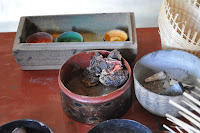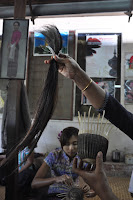(...)
We started the afternoon by visiting a lacquer craft workshop - an art which is said to have reached Myanmar in the 1st century AD by way of the Nan Chao Empire, having later developed into one of the country's most refined art form.
Raw lacque is tapped from the thitsi tree in a similar way to latex being taken from the rubber tree. As soon as that sticky-grey extract comes in contact with thair it turns black and hard. Extraordinarily fine lacquer bowls are produced around inner cores made of a mixture of horse hair and bamboo to give further flexibility in which one can press opposite sides of the bowl's rim together without the bowl breaking or the lacquer peeling off. Cheaper lacquerware comprises a gilded lacquer relief on a wooden base.
The basic structure is then coated with a layer of lacquer and clay and put in a cool place to dry. After three of four days, the vessel is sealed with a paste of lacquer and ash, the fineness of ash determining the quality of the work. After the coating has dried, the object is polished until smooth. Over time, it is given successive coats of lacquer to eliminate irregularities.
At that stage, the lacquerware is still black with ornamental and figurative designs being added later. Cheaper articles are simply painted, while expensive ones are engraved, painted and polished with similar effects being achieved with coloured reliefs. The production of such multi-coloured lacquerware cantake up to six months, involving 12 or more stages of manufacture.
Meticulouness is present in every stage of the process. I was extremely impressed by the whole stage processing and ended up buying two beautifully decorated mugs in the name of Art.
(To be continued)





















No comments:
Post a Comment